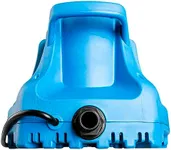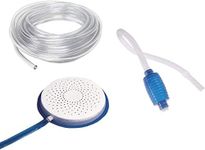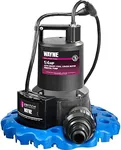Buying Guide for the Best Pool Cover Pumps
Choosing the right pool cover pump is important for keeping your pool cover free of excess water, which helps prevent damage and makes pool maintenance easier. The best pump for you will depend on the size of your pool, the amount of rainfall in your area, and how often you want to use the pump. Understanding the key features will help you select a pump that is reliable, efficient, and easy to use for your specific needs.Pumping Capacity (Gallons Per Hour - GPH)Pumping capacity tells you how much water the pump can move in an hour, usually measured in gallons per hour (GPH). This is important because a higher GPH means the pump can remove water from your pool cover more quickly, which is useful after heavy rain or if you have a large pool. Lower GPH pumps (under 800 GPH) are suitable for small pools or light rainfall, while medium GPH pumps (800-1500 GPH) work well for average-sized pools and moderate rain. High GPH pumps (over 1500 GPH) are best for large pools or areas with frequent heavy rain. To pick the right one, consider how much water typically collects on your cover and how quickly you want it removed.
Automatic vs. Manual OperationPool cover pumps can be either automatic or manual. Automatic pumps have sensors that turn the pump on when water is detected and off when the water is gone, making them convenient if you want to set it and forget it. Manual pumps require you to plug them in and turn them on yourself, which can be fine if you only need to use the pump occasionally. If you want less hands-on work and more peace of mind, an automatic pump is a good choice. If you prefer more control or only need to pump water rarely, a manual pump may be enough.
Power Source (Electric vs. Battery)Most pool cover pumps are powered by electricity and need to be plugged into an outlet, but some smaller models use batteries. Electric pumps are generally more powerful and reliable for regular use, while battery-powered pumps are more portable and can be used where outlets are not available. If your pool is close to a power source and you need to move a lot of water, an electric pump is best. If you need portability or only need to remove small amounts of water, a battery-powered pump could work.
Hose Compatibility and LengthThe hose is what carries water away from your pool cover, so it's important to check what size and type of hose the pump uses, as well as how long it is. Some pumps come with a hose, while others require you to buy one separately. A longer hose gives you more flexibility in where you can direct the water, but may reduce pumping speed slightly. Make sure the hose is long enough to reach a safe drainage area and that it fits securely to prevent leaks.
Pump Size and WeightThe size and weight of the pump affect how easy it is to move and store. Smaller, lighter pumps are easier to handle and set up, especially if you need to move the pump on and off the cover frequently. Larger pumps may be heavier but can offer more power. If you want something easy to use and store, look for a compact, lightweight model. If you prioritize performance and don't mind a heavier unit, a larger pump may be suitable.
Durability and Build QualityDurability refers to how well the pump can withstand regular use and exposure to water and weather. Look for pumps made from corrosion-resistant materials like plastic or stainless steel, as these will last longer and require less maintenance. If you plan to use the pump often or leave it outside, choosing a model with good build quality will save you trouble in the long run.













